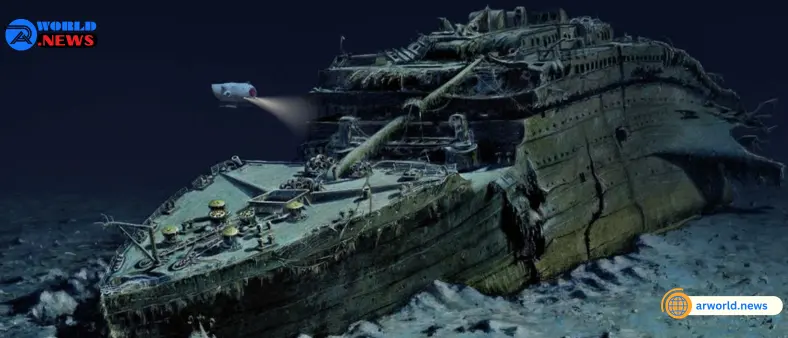The sight of the ship’s bow rising out of the shadowy Atlantic depths was what gave the Titanic’s ruin its iconic status.
However, a recent expedition has shown how gradual deterioration has left a sizable portion of the railing on the ocean floor.
This summer, after a series of dives by underwater robots, the railing that Jack and Rose immortalized in the iconic movie scene—lost its railing. The photos they took demonstrate the wreck’s deterioration after spending over a century underwater.
1,500 people perished when the ship struck an iceberg in April 1912 and sunk.
“When you think of the shipwreck, your mind automatically goes to the iconic bow of the Titanic, which has been featured in countless pop culture moments. Furthermore, it no longer appears that way, according to Tomasina Ray, head of collections at RMS Titanic Inc., the organization that oversaw the trip.
It serves as yet another illustration of the daily degradation that takes place. Frequently asked questions include “How long is Titanic going to be there?” Even though we’re viewing it live, we simply don’t know.
The group believes that at some point during the previous two years, the about 4.5-meter (14.7-foot) part of railing broke off.
The deep-sea mapping company Magellan and documentary producers Atlantic Productions conducted an expedition in 2022, and photos and a digital scan from that trip reveal that the railing was still in place even though it was beginning to give way.
According to Tomasina Ray, “the metal gave way at some point and it fell away.”
The ship, which is 3,800 meters below the surface, is losing more than just this portion to the water. Russet stalactites known as rusticles are the result of bacteria eating away at the metal structure.
It has been discovered by earlier investigations that sections of the Titanic are falling. The starboard side of the officer’s quarters was collapsing, demolishing state rooms and hiding features like the captain’s bath from view, according to dives conducted in 2019 under the supervision of explorer Victor Vescovo.
The RMS Titanic Inc. excursion this summer took place in July and August.
More than two million photos and 24 hours of high definition video of the wreck and the surrounding debris field were taken by two remotely operated vehicles (ROVs). The ship broke apart as it sunk, with the bow and stern laying roughly 800 meters apart.
In order to catalog the discoveries, the business is currently closely examining the video. In the end, it plans to produce an extremely thorough digital 3D scan of the whole accident site.
Over the next few months, more photos from the dives will be made public.
In spite of all the odds, the team has also declared the discovery of another artifact that they had hoped to uncover.
Robert Ballard, who had discovered the Titanic wreck the year before, noticed and captured a picture of a bronze monument known as the Diana of Versailles in 1986.
However, no one knew where it was located, and the 60-cm-tall figure was never recorded again.
However, it was recently found faceup in the debris field’s sediment.
James Penca, a titanic researcher and host of the Witness Titanic podcast, said, “To rediscover this year was momentous. It was like finding a needle in a haystack.”
The first-class passengers on the Titanic used to be able to see the statue.
“The ship’s most exquisite and exquisitely detailed interior was the first-class lounge. And the Diana of Versailles served as the room’s focal point,” he remarked.
Sadly, though, the lounge was destroyed when the Titanic broke in two during the sinking. Diana was torn from her mantle in the midst of the tumult and devastation, falling into the shadows of the rubble field.”
Only RMS Titanic Inc. is authorized by law to remove objects from the wreck site and holds the salvage rights to the Titanic.
The firm has recovered thousands of objects from the debris field over the years, some of which are displayed globally.
They want to recover more the following year, and one of the things they hope to recover is the Diana statue.
However, some people think the wreckage is a graveyard that ought to be preserved unaltered.
“This rediscovery of the Diana statue is the perfect argument against leaving Titanic alone,” Mr. Penca retorted.
“It was intended for viewers to view and enjoy this work of art. And now, after 112 years, that exquisite work of art is lying on the ocean floor in utter darkness. “I could never leave that on the ocean floor; I could bring Diana back so people can see her with their own eyes – the value in that, to spark a love of history, of diving, of conservation, of shipwrecks, of sculpture,” the artist said.




